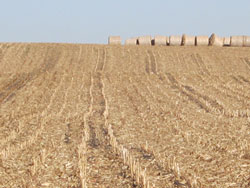New data shows that responsible harvesting of biomass for ethanol can be part of good soil management efforts for farmland.
 Iowa State University has completed analysis on data from the third year of an ongoing study for POET’s “Project LIBERTY” near Emmetsburg, Iowa to monitor how soil health is affected when crop residue is removed. The planned 25 million-gallon-per-year cellulosic ethanol plant will use corn cobs, leaves, husks and some stalk to produce renewable fuel.
Iowa State University has completed analysis on data from the third year of an ongoing study for POET’s “Project LIBERTY” near Emmetsburg, Iowa to monitor how soil health is affected when crop residue is removed. The planned 25 million-gallon-per-year cellulosic ethanol plant will use corn cobs, leaves, husks and some stalk to produce renewable fuel.
According to POET, the latest data shows that “removing about 1 bone-dry ton per acre (which is about 25 percent of the area’s above-ground crop residue) will not cause significant nutrient loss. In fact, corn yields continued to show no yield loss or moderate increases in fields with this rate of biomass removal.”
“Based on this study, we conclude that 1½ to 2 tons/acre of corn stover can safely be harvested” from fields similar to those used in the study, according to the research summary prepared by Dr. Douglas L. Karlen with USDA-Agricultural Research Service and Dr. Stuart Birrell with Iowa State University. Appropriate removal rates will vary depending on how productive the soil is in a specific area.
Project LIBERTY Director Jim Sturdevant said POET is committed to a conservative approach to biomass harvesting. “We’re contracting for fewer tons per acre to ensure good soil management even in years when yields are lower. Also, our farmers have moved away from traditional methods of stover removal: of chopping, raking, baling and leaving the field black,” he said.
Farmers harvesting for POET typically turn off the chopper on their combines and leave windrows behind during grain harvest. Farmers do not rake the biomass before the baler gathers it. Last fall, 85 farmers harvested 56,000 tons of biomass, and they are almost finished delivering it to Project LIBERTY’s 22-acre stackyard.

